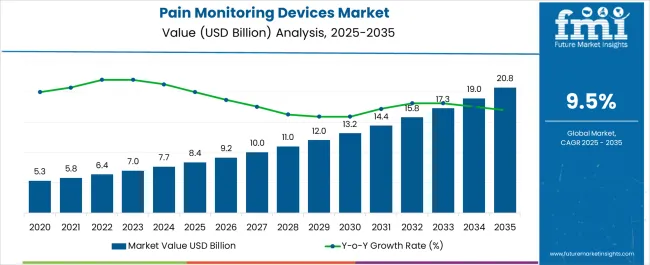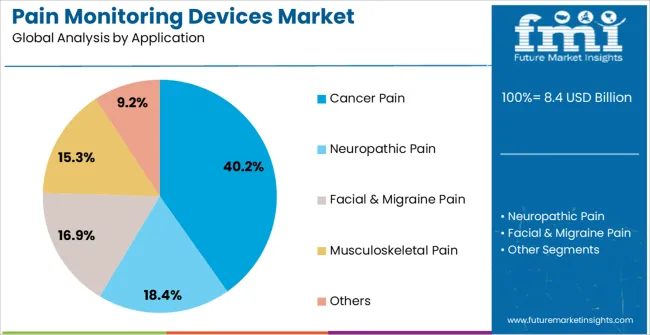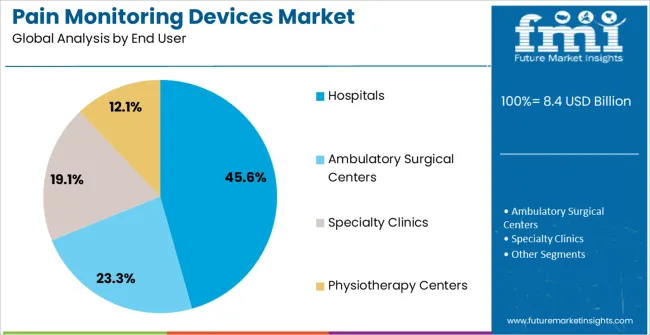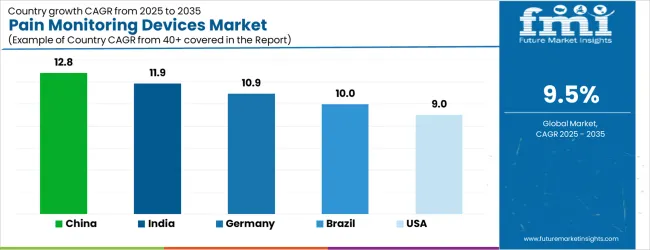The Pain Monitoring Devices Market is estimated to be valued at USD 8.4 billion in 2025 and is projected to reach USD 20.8 billion by 2035, registering a compound annual growth rate (CAGR) of 9.5% over the forecast period.

| Metric | Value |
|---|---|
| Pain Monitoring Devices Market Estimated Value in (2025 E) | USD 8.4 billion |
| Pain Monitoring Devices Market Forecast Value in (2035 F) | USD 20.8 billion |
| Forecast CAGR (2025 to 2035) | 9.5% |
The Pain Monitoring Devices market is experiencing consistent growth, driven by increasing prevalence of chronic pain conditions, cancer-related pain, and neuropathic disorders. Rising awareness of pain management solutions and advancements in medical technology are contributing to widespread adoption. Integration of wearable devices, remote monitoring, and AI-enabled analytics is enhancing treatment personalization and patient outcomes.
Hospitals, clinics, and home-care providers are increasingly investing in advanced monitoring systems to improve clinical decision-making and reduce complications associated with ineffective pain management. The demand is further supported by the need for minimally invasive, non-opioid-based interventions that provide continuous pain assessment and management. Regulatory emphasis on patient safety, data security, and device efficacy is encouraging healthcare providers to adopt certified solutions.
Technological innovations, combined with growing healthcare infrastructure and reimbursement support, are shaping the market landscape As healthcare providers prioritize patient-centric care, the Pain Monitoring Devices market is expected to witness sustained growth, with opportunities emerging from both hospital and home-based monitoring solutions.
The pain monitoring devices market is segmented by product type, application, end user, and geographic regions. By product type, pain monitoring devices market is divided into Transcutaneous Electrical Nerve Stimulation (TENS), Radiofrequency Ablation Device, Analgesic Infusion Pumps, and Neurostimulators. In terms of application, pain monitoring devices market is classified into Cancer Pain, Neuropathic Pain, Facial & Migraine Pain, Musculoskeletal Pain, and Others. Based on end user, pain monitoring devices market is segmented into Hospitals, Ambulatory Surgical Centers, Specialty Clinics, and Physiotherapy Centers. Regionally, the pain monitoring devices industry is classified into North America, Latin America, Western Europe, Eastern Europe, Balkan & Baltic Countries, Russia & Belarus, Central Asia, East Asia, South Asia & Pacific, and the Middle East & Africa.

The Transcutaneous Electrical Nerve Stimulation (TENS) segment is projected to hold 35.7% of the market revenue in 2025, making it the leading product type. Growth is being driven by the device’s non-invasive approach, proven efficacy in reducing pain intensity, and compatibility with various clinical and home-care applications. TENS devices enable targeted stimulation of nerve pathways, providing real-time pain relief while minimizing dependence on pharmacological interventions.
Continuous improvements in electrode technology, device portability, and user-friendly interfaces have enhanced patient adherence and clinical acceptance. The ability to monitor and adjust stimulation parameters via software and mobile applications further strengthens adoption.
Hospitals and rehabilitation centers leverage TENS devices for postoperative pain management, chronic pain treatment, and physiotherapy support With the rising emphasis on patient safety, personalized treatment, and minimally invasive solutions, the TENS segment is expected to maintain its leading position, supported by ongoing technological innovation and growing patient awareness.

The cancer pain application segment is anticipated to account for 40.2% of the market revenue in 2025, establishing it as the leading application area. Growth is being driven by the rising global incidence of cancer and increasing awareness regarding effective pain management in oncology. Pain monitoring devices allow for real-time assessment of pain intensity and pattern, facilitating timely interventions and improved patient outcomes.
Integration with hospital information systems and wearable technology enables continuous monitoring, early detection of complications, and personalized therapy adjustments. The focus on non-opioid-based pain control and quality-of-life improvement further supports adoption.
Increasing investments by healthcare institutions in advanced monitoring solutions, along with government and private initiatives for cancer care, are reinforcing demand As clinical guidelines increasingly recommend structured pain assessment and management in oncology, the cancer pain segment is expected to remain the primary driver of market growth, supported by continuous innovation in device technology, analytics, and patient engagement solutions.

The hospitals end-use segment is projected to hold 45.6% of the market revenue in 2025, making it the leading end-user category. Growth is being driven by hospitals’ need for structured pain management programs that provide accurate, real-time assessment of patients’ conditions across departments. Hospitals leverage pain monitoring devices for postoperative care, chronic pain management, oncology treatment, and rehabilitation, improving patient outcomes while optimizing resource utilization.
Integration with electronic health records, data analytics platforms, and patient monitoring systems allows for efficient care coordination and personalized treatment plans. Increasing awareness among healthcare providers regarding patient safety, regulatory compliance, and evidence-based pain management practices is reinforcing adoption.
Technological advancements such as wearable sensors, AI-enabled analytics, and cloud-based monitoring solutions are further enhancing the utility of pain monitoring devices in hospital settings As hospitals continue to prioritize quality of care, operational efficiency, and patient satisfaction, the segment is expected to remain the primary driver of market revenue, supported by increasing investments in healthcare infrastructure and digital health technologies.
Pain is an unpleasant sensation caused by injury and illness. The treatment of pain is led by the history of its origin, such as the duration, aggravating, intensity, and relieving conditions. In order to diagnose the cause of pain, pain monitoring devices are used. Pain monitoring devices comprise of a non-invasive finger probe which continuously records the multiple pain-related physiological signals.
Pain monitoring devices have become a method of choice because of its high efficacy, safety and, ease of use. Pain monitoring devices are increasingly used for the treatment of many diseases such as cancer and cardiac arrhythmia.

| Country | CAGR |
|---|---|
| China | 12.8% |
| India | 11.9% |
| Germany | 10.9% |
| Brazil | 10.0% |
| USA | 9.0% |
| UK | 8.1% |
| Japan | 7.1% |
The Pain Monitoring Devices Market is expected to register a CAGR of 9.5% during the forecast period, exhibiting varied country level momentum. China leads with the highest CAGR of 12.8%, followed by India at 11.9%. Developed markets such as Germany, France, and the UK continue to expand steadily, while the USA is likely to grow at consistent rates. Japan posts the lowest CAGR at 7.1%, yet still underscores a broadly positive trajectory for the global Pain Monitoring Devices Market.
In 2024, Germany held a dominant revenue in the Western Europe market and is expected to grow with a CAGR of 10.9%. The USA Pain Monitoring Devices Market is estimated to be valued at USD 3.0 billion in 2025 and is anticipated to reach a valuation of USD 3.0 billion by 2035. Sales are projected to rise at a CAGR of 0.0% over the forecast period between 2025 and 2035. While Japan and South Korea markets are estimated to be valued at USD 402.5 million and USD 231.1 million respectively in 2025.

| Item | Value |
|---|---|
| Quantitative Units | USD 8.4 Billion |
| Product Type | Transcutaneous Electrical Nerve Stimulation (TENS), Radiofrequency Ablation Device, Analgesic Infusion Pumps, and Neurostimulators |
| Application | Cancer Pain, Neuropathic Pain, Facial & Migraine Pain, Musculoskeletal Pain, and Others |
| End User | Hospitals, Ambulatory Surgical Centers, Specialty Clinics, and Physiotherapy Centers |
| Regions Covered | North America, Europe, Asia-Pacific, Latin America, Middle East & Africa |
| Country Covered | United States, Canada, Germany, France, United Kingdom, China, Japan, India, Brazil, South Africa |
| Key Companies Profiled | B Braun Melsungen AG, Baxter, Boston Scientific Corporation or its affiliates, Nevro Corp., Enovis, OMRON Healthcare INC, Medtronic, ICU Medical Inc, Abott, Stryker, and Stimwave LLC |
The global pain monitoring devices market is estimated to be valued at USD 8.4 billion in 2025.
The market size for the pain monitoring devices market is projected to reach USD 20.8 billion by 2035.
The pain monitoring devices market is expected to grow at a 9.5% CAGR between 2025 and 2035.
The key product types in pain monitoring devices market are transcutaneous electrical nerve stimulation (tens), radiofrequency ablation device, analgesic infusion pumps and neurostimulators.
In terms of application, cancer pain segment to command 40.2% share in the pain monitoring devices market in 2025.






Our Research Products

The "Full Research Suite" delivers actionable market intel, deep dives on markets or technologies, so clients act faster, cut risk, and unlock growth.

The Leaderboard benchmarks and ranks top vendors, classifying them as Established Leaders, Leading Challengers, or Disruptors & Challengers.

Locates where complements amplify value and substitutes erode it, forecasting net impact by horizon

We deliver granular, decision-grade intel: market sizing, 5-year forecasts, pricing, adoption, usage, revenue, and operational KPIs—plus competitor tracking, regulation, and value chains—across 60 countries broadly.

Spot the shifts before they hit your P&L. We track inflection points, adoption curves, pricing moves, and ecosystem plays to show where demand is heading, why it is changing, and what to do next across high-growth markets and disruptive tech

Real-time reads of user behavior. We track shifting priorities, perceptions of today’s and next-gen services, and provider experience, then pace how fast tech moves from trial to adoption, blending buyer, consumer, and channel inputs with social signals (#WhySwitch, #UX).

Partner with our analyst team to build a custom report designed around your business priorities. From analysing market trends to assessing competitors or crafting bespoke datasets, we tailor insights to your needs.
Supplier Intelligence
Discovery & Profiling
Capacity & Footprint
Performance & Risk
Compliance & Governance
Commercial Readiness
Who Supplies Whom
Scorecards & Shortlists
Playbooks & Docs
Category Intelligence
Definition & Scope
Demand & Use Cases
Cost Drivers
Market Structure
Supply Chain Map
Trade & Policy
Operating Norms
Deliverables
Buyer Intelligence
Account Basics
Spend & Scope
Procurement Model
Vendor Requirements
Terms & Policies
Entry Strategy
Pain Points & Triggers
Outputs
Pricing Analysis
Benchmarks
Trends
Should-Cost
Indexation
Landed Cost
Commercial Terms
Deliverables
Brand Analysis
Positioning & Value Prop
Share & Presence
Customer Evidence
Go-to-Market
Digital & Reputation
Compliance & Trust
KPIs & Gaps
Outputs
Full Research Suite comprises of:
Market outlook & trends analysis
Interviews & case studies
Strategic recommendations
Vendor profiles & capabilities analysis
5-year forecasts
8 regions and 60+ country-level data splits
Market segment data splits
12 months of continuous data updates
DELIVERED AS:
PDF EXCEL ONLINE
Pain Management Devices Market Growth - Trends & Forecast 2025 to 2035
Dose Monitoring Devices Market - Growth & Demand 2025 to 2035
Noise Monitoring Devices Market Size and Share Forecast Outlook 2025 to 2035
Nerve Monitoring Devices Market Insights - Growth & Forecast 2025 to 2035
Lactate Monitoring Devices Market Size and Share Forecast Outlook 2025 to 2035
Patient Monitoring Devices Market Size and Share Forecast Outlook 2025 to 2035
Epilepsy Monitoring Devices Market Growth - Trends & Forecast 2025 to 2035
Compliance Monitoring Devices Market Trends and Forecast 2025 to 2035
Vital Signs Monitoring Devices Market Analysis - Trends & Forecast 2025 to 2035
Blood Glucose Monitoring Devices Market Size and Share Forecast Outlook 2025 to 2035
Remote Patient Monitoring Devices Market Size and Share Forecast Outlook 2025 to 2035
Demand for Glucose Monitoring Devices in EU Size and Share Forecast Outlook 2025 to 2035
Continuous Cardiac Monitoring Devices Market Size and Share Forecast Outlook 2025 to 2035
Pet Blood Pressure Monitoring Devices Market Size and Share Forecast Outlook 2025 to 2035
Frictionless Remote Monitoring Devices Market Size and Share Forecast Outlook 2025 to 2035
Intraoperative Neuromonitoring Devices Market
Cardiac Rhythm Remote Monitoring Devices Market Size and Share Forecast Outlook 2025 to 2035
Cardiac Monitoring And Cardiac Rhythm Management Devices Market Size and Share Forecast Outlook 2025 to 2035
Non-Invasive Blood Glucose Monitoring Devices Market Size and Share Forecast Outlook 2025 to 2035
Monitoring Tool Market Size and Share Forecast Outlook 2025 to 2035

Thank you!
You will receive an email from our Business Development Manager. Please be sure to check your SPAM/JUNK folder too.
Chat With
MaRIA